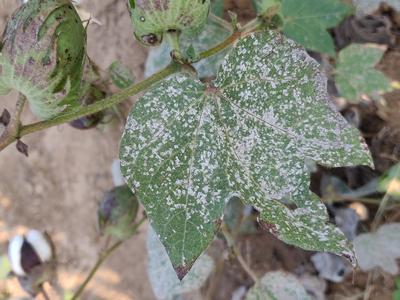Grey Mildew of Cotton
Mycosphaerella areola
Fungus
In a Nutshell
- Small, light green to yellowish, angular spots.
- Whitish grey powdery growth beneath the spots.
- smaller spots merge together and form bigger spots.
- Leaves dry and drop prematurely leaving only naked branches.
Can also be found in
Symptoms
Symptoms usually appear towards the end of the growing season. On older leaves, small, light green to yellowish, angular spots, that are limited by the veins, appear on the upper surface. Whitish grey powdery growth just beneath the spots on lower side. During periods of high humidity, both surfaces become covered with silvery white fungal growth. Severely affected leaves become necrotic, curly and dry, show a red-brown color and drop prematurely. The defoliation weakens the plant and its productivity. Young leaves start to show symptoms. Infected bolls lose strength, open prematurely or break during pulling and threshing at harvest.
Recommendations

Organic Control
Seed treatment with products containing Pseudomonas fluorescens (10g/kg seeds) can be done. Spraying of a solution containing this bacterium every 10 days reduces the infection significantly. Other bacteria (Bacillus circulans and Serratia marcescens) have been used to control other species of Mycosphaerella and reduce the incidence of related diseases in other crops. Spray of 3 gm wettable sulphur per one litre of water or dusting of 8-10 kg of sulphur powder per hectare are other possibilities.

Chemical Control
Always consider an integrated approach with preventive measures together with biological treatments if available. At early stages of the disease or low severity, biological treatments above should be considered. At advanced stages of the disease or increasing severity the application of new fungicides containing propiconazole or hexaconazole (2ml/l) are recommended. Repeat treatment after one week to 10 days.
What caused it?
The symptoms are caused by the fungus Mycosphaerella areola, which survives on plant debris or volunteer plants from previous seasons. These are the main sources of inoculum in the new season. Temperatures between 20-30 °C, wet and humid conditions (80% or more) and intermittent rainfalls promote the infection and the progression of the disease. Cool weather coupled with prolonged dewy nights for several days in a row, even in the absence of rain, also favor the fungus. The spores are produced in leaf lesions and are subsequently transported by the wind to healthy plants, resulting in secondary infections. Plants are more vulnerable during the late part of the season, just before or during boll set.
Preventive Measures
- Plant resistant varieties, (several are available ).
- Plant on raised ridges to improve drainage.
- Do not sow to early or too late during the season.
- Space plants to allow canopy to dry quickly after rainfall.
- Regularly observe the cotton field for symptoms of the disease.
- Remove leaves displaying symptoms and destroy them.
- Control susceptible weeds in and around the field.
- Destroy volunteer crops from previous seasons.
- Use a drip irrigation system and avoid overhead irrigation to minimize leaf wetness.
- Water plants in the morning so plants dry during the day.
- Avoid frequent irrigation to maintain a drier canopy and soil surface.
- Avoid excessive application of nitrogenous fertilizers or manures.
- Do not work in the field when plants are wet.
- Remove plant residues and burn them at a distance of the cotton field.
- Implement 2- or 3-year crop rotation with non-hosts, for example cereals.



